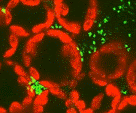Plant Pathology, Department of

Department of Plant Pathology: Faculty Publications
Document Type
Article
Date of this Version
2-14-2022
Citation
https://doi.org/10.1021/acs.chemrev.2c00118
Abstract
Viruses are a heterogeneous ensemble of entities, all sharing the need for a suitable host to replicate. They are extremely diverse, varying in morphology, size, nature, and complexity of their genomic content. Typically, viruses use host-encoded glycosyltransferases and glycosidases to add and remove sugar residues from their glycoproteins. Thus, the structure of the glycans on the viral proteins have, to date, typically been considered to mimick those of the host. However, the more recently discovered large and giant viruses differ from this paradigm. At least some of these viruses code for an (almost) autonomous glycosylation pathway. These viral genes include those that encode the production of activated sugars, glycosyltransferases, and other enzymes able to manipulate sugars at various levels. This review focuses on large and giant viruses that produce carbohydrate-processing enzymes. A brief description of those harboring these features at the genomic level will be discussed, followed by the achievements reached with regard to the elucidation of the glycan structures, the activity of the proteins able to manipulate sugars, and the organic synthesis of some of these virus-encoded glycans. During this progression, we will also comment on many of the challenging questions on this subject that remain to be addressed.


Comments
Used by permission